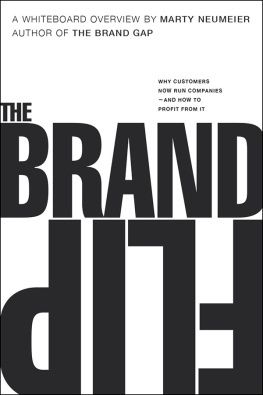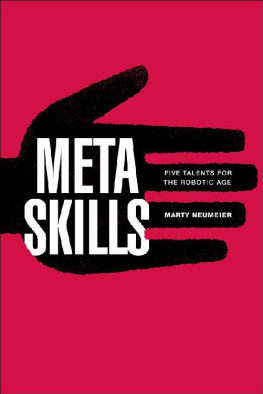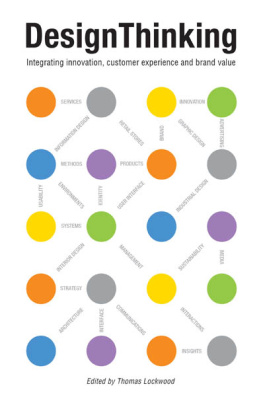The Designful Company
How to Build a Culture of Nonstop Innovation
Marty Neumeier

THE DESIGNFUL COMPANY
How to Build a Culture of Nonstop Innovation
A Whiteboard Overview By Marty Neumeier
New Riders
1249 Eighth Street
Berkeley, CA 94710
510/524-2178
510/524-2221 (fax)
New Riders is an imprint of Peachpit, a division of Pearson Education
Find us on the World Wide Web at: www.peachpit.com
To report errors, please send a note to
Copyright 2009 by Marty Neumeier
Project Editor: MICHAEL J NOLAN
Production Editor: DAVID VAN NESS
Book Designer: CLAUDIA FUNG
Proofreader: LIZ WELCH
Indexer: REBECCA PLUNKETT
Notice of Rights
All rights reserved. No part of this book may be reproduced or transmitted in any form by any means, electronic, mechanical, photocopying, recording, or otherwise, without the prior written permission of the publisher. For information on getting permission for reprints and excerpts, contact .
Notice of Liability
The information in this book is distributed on an As Is basis without warranty. While every precaution has been taken in the preparation of the book, neither the author nor Peachpit shall have any liability to any person or entity with respect to any loss or damage caused or alleged to be caused directly or indirectly by the instructions contained in this book or by the computer software and hardware products described in it.
Trademarks
Many of the designations used by manufacturers and sellers to distinguish their products are claimed as trademarks. Where those designations appear in this book, and Peachpit was aware of a trademark claim, the designations appear as requested by the owner of the trademark. All other product names and services identified throughout this book are used in editorial fashion only and for the benefit of such companies with no intention of infringement of the trademark. No such use, or the use of any trade name, is intended to convey endorsement or other affiliation with this book.
ISBN 13: 987-0-321-58006-1
ISBN 10: 0-321-58006-0
9 8 7 6 5 4 3 2 1
Printed and bound in the United States of America
TO MY DESIGNFUL DAUGHTER SARA
Table of Contents
Preface
Welcome to the future of business. Whether youre the CEO of a global firm or the newest employee in a startup, the principles in these pages will help you ride powerful currents of change. Its too late to label this book a manifestothe revolution has already begun. Instead, I hope THE DESIGNFUL COMPANY will serve as your personal guide to the challenging world of nonstop innovation.
In my first whiteboard book, THE BRAND GAP , I showed how to bridge the distance between business strategy and customer experience with five interconnected disciplines. In my second book, ZAG , I drilled down into the first and most strategic of these five disciplines, radical differentiation. Now, in THE DESIGNFUL COMPANY , Ill show you how to transform your company by unleashing the full potential of creative collaboration.
I know your time is valuable, so once again Ive compressed my thoughts into an airplane booka quick read designed to deliver solid insights for years to come. Ill be watching as you design an exciting future for yourself, your company, and the small community we call Earth.
Marty Neumeier
Introduction
BEAUTY EMERGES FROM ANY DESIGN THAT IS WORKING.
BUCKMINSTER FULLER
The Age of Wicked Problems
Industrial Age thinking has delivered some dazzling capabilities, including the power to churn out high-quality products at affordable prices. Yet it has also trapped us in a tangle of what social planner Horst Rittel labeled wicked problemsproblems so persistent, pervasive, or slippery that they seem insoluble. Unlike the relatively tame problems found in math, chess, or cost accounting, wicked problems tend to shift disconcertingly with every attempt to solve them. Moreover, the solutions are never right or wrong, just better or worse.
The worlds wicked problems crowd us like piranha. You know the list: pollution, overpopulation, dwindling natural resources, global warming, technological warfare, and a lopsided distribution of power that has failed to address massive ignorance or Third World hunger. In the world of business, managers face a subset of these problems: breakneck change, omniscient customers, balkanized markets, rapacious shareholders, traitorous employees, regulatory headlocks, and pricing pressure from desperate global competitors with little to lose and everything to gain.
]
Sponsored by Neutron and Stanford University
1 Balancing long-term goals with short-term demands
2 Predicting the returns on innovative concepts
3 Innovating at the increasing speed of change
4 Winning the war for world-class talent
5 Combining profitability with social responsibility
6 Protecting margins in a commoditizing industry
7 Multiplying success by collaborating across silos
8 Finding unclaimed yet profitable market space
9 Addressing the challenge of eco-sustainability
10 Aligning strategy with customer experience
[] A wicked problem is a puzzle so persistent, pervasive, or slippery that it can seem insoluble.
In a 2008 survey sponsored by Neutron and Stanford University, 1,500 top executives were asked to identify the wickedest problems plaguing their companies today. While the list included the usual suspects of profits and growth, it also revealed concerns that hadnt shown up on corporate radar screens until now: aligning strategy with customer experience, addressing eco-sustainability, collaborating across silos, and embracing social responsibility. The number-one wicked problem cited by leaders was the conflict between long-term goals and short-term demands.
Clearly, these were not the concerns of 20th-century managers. The last management obsession of the 20th century was Six Sigma, the total-quality movement inspired by Dr. W. Edwards Deming and his postwar work with the Japanese. Six Sigma has been so successful that quality has virtually become a commodity. Customers now expect every product and service to be reliable, affording no single company a competitive advantage. Unfortunately, the more progressive elements of Demings philosophy were all but ignored by a business mindset that preferred the measurable over the meaningful.
A One-Track Mind
When we look around and see todays companies and brands beset by distrustful customers, disengaged employees, and suspicious communities, we can link these problems to a legacy management style that lacks any real humanity. The model for 20th-century management was not the warm humanism of the Renaissance, but the cold mechanics of the assembly line, the laser-like focus of Newtonian science applied to the manufacture of wealth. The assembly line was intentionally blind to morality, emotions, and human aspirationall the better to make your competitors and customers lose so you can win.
Yet business, at bottom, is not mechanical but human. Today were finding that innovation without emotion is uninteresting. Products without aesthetics are uncompelling. Brands without meaning are undesirable. And a business without ethics is unsustainable. The management model that got us here is underpowered to move us forward. To succeed, the new model must replace the win-lose nature of the assembly line with the win-win nature of the network.









